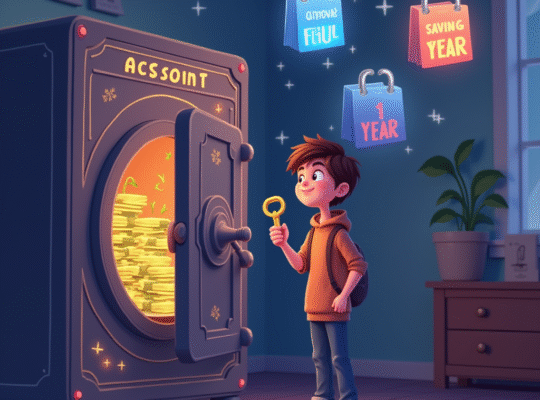A savings account is a type of bank account made for storing money you don’t want to spend right away.
Unlike a checking account (which is meant for everyday spending), a savings account helps you hold onto money — and grow it a little, over time. That’s because when you keep money in a savings account, the bank pays you interest for letting it sit there.
It’s like a slow, steady way of making your money do a tiny bit of work — while you do nothing.
How Does Interest Work?
When you put money into a savings account, the bank uses some of that money to help other people (like giving loans). In return, they give you a small payment called interest — usually calculated as a percentage from the principal amount ( initial amount deposited in the account) how much money you’ve kept in the account .
Example:
If your savings account earns 2% interest per year and you keep $100 in it for 12 months, you’ll earn about $2.
Some banks offer higher interest rates than others — especially online banks — so it’s good to compare.
Pros
1. It Grows Your Money (a Little Bit)
Unlike a checking account, savings accounts earn interest, so your money can increase over time — even while it just sits there.
2. It Helps You Save for Goals
You can use it to set aside money for things like a concert, a new phone, or even college. It keeps your spending and saving separate.
3. It’s Safer Than Cash
Cash can be lost or stolen. Money in a savings account is protected by the bank (and in most cases, insured by the government up to a certain amount).
4. No Daily Spending
Most savings accounts don’t come with a debit card — and that’s a good thing. It makes it harder to spend money on impulse.
Cons (The Not-So-Great Stuff)
1. You Can’t Use It Like a Wallet
You usually can’t use a savings account to pay for things directly. You need to transfer money to a checking account or take it out.
2. Withdrawal Limits
Some banks limit how many times you can take money out of your savings each month (usually around 6 times). Go over that, and you might get hit with fees.
3. Low Interest Rates (At Some Banks)
Some banks offer interest that’s barely anything — like 0.01%. At that rate, even if you save $1,000, you’d only make 10 cents in a year. That’s why it’s smart to shop around for better rates.
Things to Watch Out For
- Compare interest rates. Online banks often offer higher rates than traditional banks.
- Avoid excessive withdrawals. Try not to move money in and out too often, or you might face fees.
- Check for monthly maintenance fees. Some banks charge you if you don’t keep a minimum balance or make regular deposits. Look for no-fee options.
Best For
- People saving up for short- or medium-term goals
- Teens learning to build a habit of saving
- Anyone who wants to keep money separate from everyday spending
- Emergency funds or rainy day savings
A savings account isn’t for flashy money moves — it’s for the quiet kind of growth. The kind that adds up slowly, over time. It’s a tool for future you — the version of yourself that might want something bigger down the road.
If a checking account is your money’s “on-the-go” bag, then a savings account is the drawer you don’t open every day — but feel good knowing it’s full.





